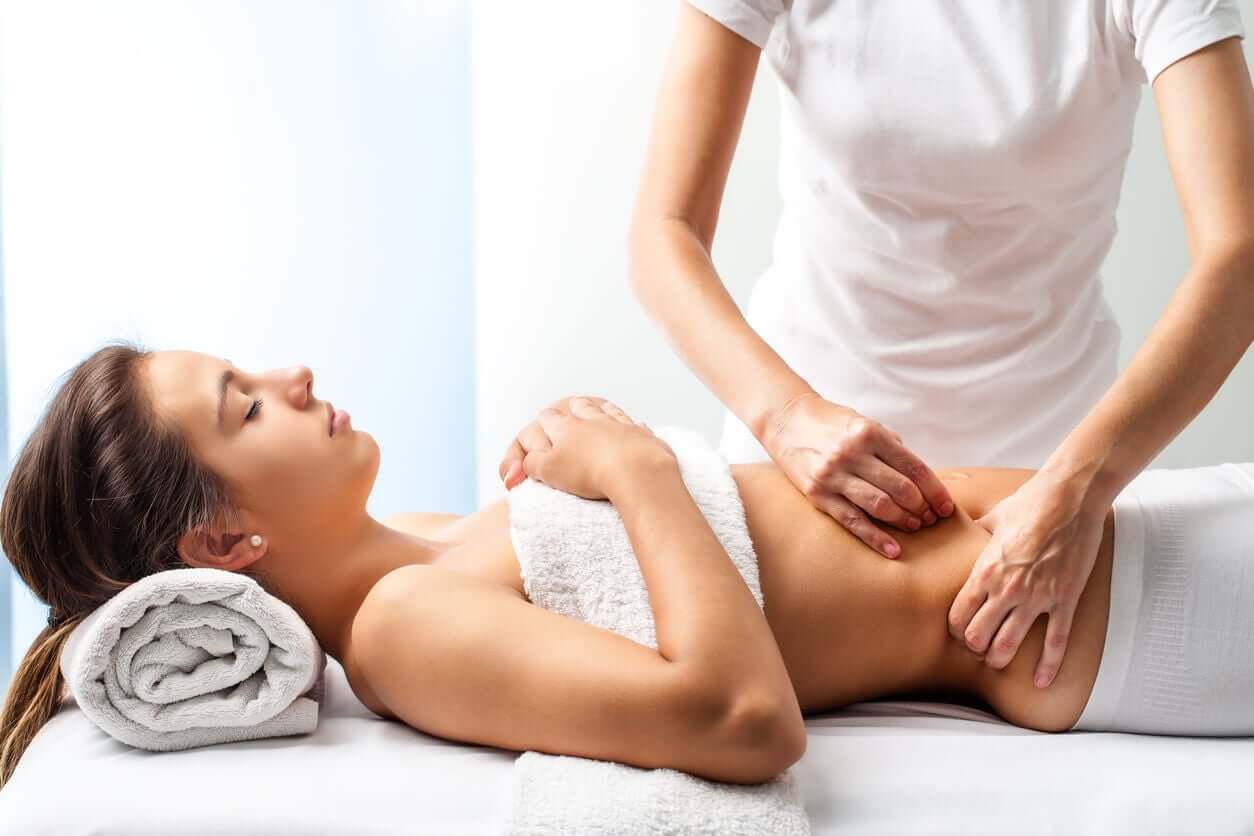Gynecological Osteopathy for Menstrual Cramps


Written and verified by degree in physical education and sports Andrés Felipe Cardona Lenis
Have you heard about the effectiveness of gynecological osteopathy in relieving menstrual cramps? Probably not. That’s why we want to tell you what this discipline is about and how it affects health in general.
The pains caused by menstruation are characterized by being intense and persistent. Obviously, this feeling is subjective and varies with each woman. But many times, the severity of the pain is what can raise suspicions about the existence of some disease.
In general, the term dysmenorrhea is used to refer to pain related to a woman’s period and, without a doubt, you’ve experienced it at some point.
Painful periods
Dysmenorrhea refers to severe pain that occurs in the context of menstruation, either before or during. It’s generally colicky and focuses on the pelvic area. In fact, it’s considered to be one of the most common causes of pelvic pain in women.
One of the characteristics of dysmenorrhea is that the pain that women perceive is moderate to severe and can correspond to different reasons. To better identify the causes, it’s classified into two main types:
- Primary (when there’s no other associated disease)
- Secondary (when the pain occurs as a result of some disease)

The causes of dysmenorrhea
As we mentioned, there are several causes of dysmenorrhea, and we’ll mention some of them below:
- Uterine pathologies that occur with imbalances in the levels of prostaglandins (they cause involuntary contractions of the uterus)
- Endometriosis (favors the growth of endometrial-like tissue outside the uterus, somewhere in the abdominal or pelvic cavity)
- Ectopic pregnancy
- Fibroids or uterine polyps
- Sexually transmitted infections
Other symptoms that accompany period pain
Dysmenorrhea is a crampy pain. In other words, it appears in the form of intense spasms that subside after a while and then reappear.
Due to the discomfort they cause in the woman’s body, they can be accompanied by some involuntary symptoms (triggered by stimuli from the autonomic nervous system ), such as those mentioned below:
- Headache
- Nausea and vomiting
- Pain in the lower back
- Fatigue
- Diarrhea
Pain during menstruation is normal, but if it involves any of these symptoms, you should pay more attention and, when in doubt, consult your doctor.
Osteopathy for menstrual cramps
Osteopathy is an alternative medicine that focuses on body movements and massage. A specialist (an osteopath) must perform it and should first make a diagnosis of the condition before offering the appropriate treatment.
One of the greatest benefits of osteopathy is that it reduces the consumption of pain medications, such as analgesics or antispasmodics. Through non-pharmacological techniques, you can greatly improve the discomfort of your period.
According to a study published by the International Journal of Health Sciences, osteopathy treatment has proven to be effective as a pain management strategy of all kinds. For this reason, try to consult your osteopath if you can’t control it with conventional treatments.
You may be interested: Tips to Help Reduce Your Menstrual Pain
What is gynecological osteopathy?
Gynecological osteopathy aims at treating a woman’s pelvic or lower abdomen ailments. In short, those having to do with the female reproductive system and its functions.
The technique that the osteopath uses varies according to the diagnosis of each woman. But, in general, there are two approaches: The internal route and the external route.
The internal technique
The internal technique is the least common of all and is only performed under the authorization of the patient, as it’s usually invasive and somewhat painful. However, it’s very effective for treating poor uterine positions or internal scars.
External technique
The external technique is much more common within gynecological osteopathy and takes place from outside the body, either through massages or maneuvers that stimulate blood circulation. In addition, it also helps to release muscle tension and the affected organs.
The professional performs this technique in certain cardinal points of the body, such as the skull, pelvis, and lumbar area, due to the influence that each of them has on the body.
Some considerations about gynecological osteopathy
Unlike other treatments, osteopathy doesn’t require any special preparation or care after the session. In any case, it’s best to avoid sudden and exaggerated movements so as not to generate more discomfort in the recently manipulated pelvic area.

Osteopathy and menstrual pain: Mixed opinions
Although osteopathy has been shown to reduce the discomfort of dysmenorrhea, there are many opinions about it.
Traditional medicine doesn’t recognize this discipline as a real science. However, today, there are several studies that support osteopathy as a medical alternative. Treatment for low back pain is one such example.
At the same time, the World Health Organization (WHO) recognizes osteopathy as an independent health profession.
Therefore, before starting any type of alternative treatment, we suggest you investigate thoroughly and talk about it with your general practitioner.
Have you heard about the effectiveness of gynecological osteopathy in relieving menstrual cramps? Probably not. That’s why we want to tell you what this discipline is about and how it affects health in general.
The pains caused by menstruation are characterized by being intense and persistent. Obviously, this feeling is subjective and varies with each woman. But many times, the severity of the pain is what can raise suspicions about the existence of some disease.
In general, the term dysmenorrhea is used to refer to pain related to a woman’s period and, without a doubt, you’ve experienced it at some point.
Painful periods
Dysmenorrhea refers to severe pain that occurs in the context of menstruation, either before or during. It’s generally colicky and focuses on the pelvic area. In fact, it’s considered to be one of the most common causes of pelvic pain in women.
One of the characteristics of dysmenorrhea is that the pain that women perceive is moderate to severe and can correspond to different reasons. To better identify the causes, it’s classified into two main types:
- Primary (when there’s no other associated disease)
- Secondary (when the pain occurs as a result of some disease)

The causes of dysmenorrhea
As we mentioned, there are several causes of dysmenorrhea, and we’ll mention some of them below:
- Uterine pathologies that occur with imbalances in the levels of prostaglandins (they cause involuntary contractions of the uterus)
- Endometriosis (favors the growth of endometrial-like tissue outside the uterus, somewhere in the abdominal or pelvic cavity)
- Ectopic pregnancy
- Fibroids or uterine polyps
- Sexually transmitted infections
Other symptoms that accompany period pain
Dysmenorrhea is a crampy pain. In other words, it appears in the form of intense spasms that subside after a while and then reappear.
Due to the discomfort they cause in the woman’s body, they can be accompanied by some involuntary symptoms (triggered by stimuli from the autonomic nervous system ), such as those mentioned below:
- Headache
- Nausea and vomiting
- Pain in the lower back
- Fatigue
- Diarrhea
Pain during menstruation is normal, but if it involves any of these symptoms, you should pay more attention and, when in doubt, consult your doctor.
Osteopathy for menstrual cramps
Osteopathy is an alternative medicine that focuses on body movements and massage. A specialist (an osteopath) must perform it and should first make a diagnosis of the condition before offering the appropriate treatment.
One of the greatest benefits of osteopathy is that it reduces the consumption of pain medications, such as analgesics or antispasmodics. Through non-pharmacological techniques, you can greatly improve the discomfort of your period.
According to a study published by the International Journal of Health Sciences, osteopathy treatment has proven to be effective as a pain management strategy of all kinds. For this reason, try to consult your osteopath if you can’t control it with conventional treatments.
You may be interested: Tips to Help Reduce Your Menstrual Pain
What is gynecological osteopathy?
Gynecological osteopathy aims at treating a woman’s pelvic or lower abdomen ailments. In short, those having to do with the female reproductive system and its functions.
The technique that the osteopath uses varies according to the diagnosis of each woman. But, in general, there are two approaches: The internal route and the external route.
The internal technique
The internal technique is the least common of all and is only performed under the authorization of the patient, as it’s usually invasive and somewhat painful. However, it’s very effective for treating poor uterine positions or internal scars.
External technique
The external technique is much more common within gynecological osteopathy and takes place from outside the body, either through massages or maneuvers that stimulate blood circulation. In addition, it also helps to release muscle tension and the affected organs.
The professional performs this technique in certain cardinal points of the body, such as the skull, pelvis, and lumbar area, due to the influence that each of them has on the body.
Some considerations about gynecological osteopathy
Unlike other treatments, osteopathy doesn’t require any special preparation or care after the session. In any case, it’s best to avoid sudden and exaggerated movements so as not to generate more discomfort in the recently manipulated pelvic area.

Osteopathy and menstrual pain: Mixed opinions
Although osteopathy has been shown to reduce the discomfort of dysmenorrhea, there are many opinions about it.
Traditional medicine doesn’t recognize this discipline as a real science. However, today, there are several studies that support osteopathy as a medical alternative. Treatment for low back pain is one such example.
At the same time, the World Health Organization (WHO) recognizes osteopathy as an independent health profession.
Therefore, before starting any type of alternative treatment, we suggest you investigate thoroughly and talk about it with your general practitioner.
All cited sources were thoroughly reviewed by our team to ensure their quality, reliability, currency, and validity. The bibliography of this article was considered reliable and of academic or scientific accuracy.
- Licciardone, J. C., Brimhall, A. K., & King, L. N. (2005). Osteopathic manipulative treatment for low back pain: A systematic review and meta-analysis of randomized controlled trials. BMC Musculoskeletal Disorders. https://doi.org/10.1186/1471-2474-6-43
- World Health Organization (Hs). (2010). Benchmarks for training in traditional/complementary and alternative medicine: Benchmarks for Training in Osteopathy. World Health Organization. https://www.who.int/medicines/areas/traditional/BenchmarksforTraininginOsteopathy.pdf
- Zecchillo, D., Acquati, A., Aquino, R., Pisa, V., Uberti, S., & Ratti, S. (2017). Osteopathic Manipulative Treatment of Primary Dysmenorhea and Related Factors: A Randomized Controlled Trial. International Journal of Medical Research & Health Sciences.https://www.researchgate.net/publication/321757701_Osteopathic_Manipulative_Treatment_of_Primary_Dysmenorrhea_and_Related_Factors_A_Randomized_Controlled_Trial
- Instituto Nacional de Trastornos Neurológicos y Accidentes Cerebrovasculares. Trastornos del sistema nervioso autónomo. MedlinePlus. [Internet] Disponible en: https://medlineplus.gov/spanish/autonomicnervoussystemdisorders.html#:~:text=El%20sistema%20nervioso%20aut%C3%B3nomo%20es,estrechamiento%20de%20los%20vasos%20sangu%C3%ADneos.
This text is provided for informational purposes only and does not replace consultation with a professional. If in doubt, consult your specialist.








